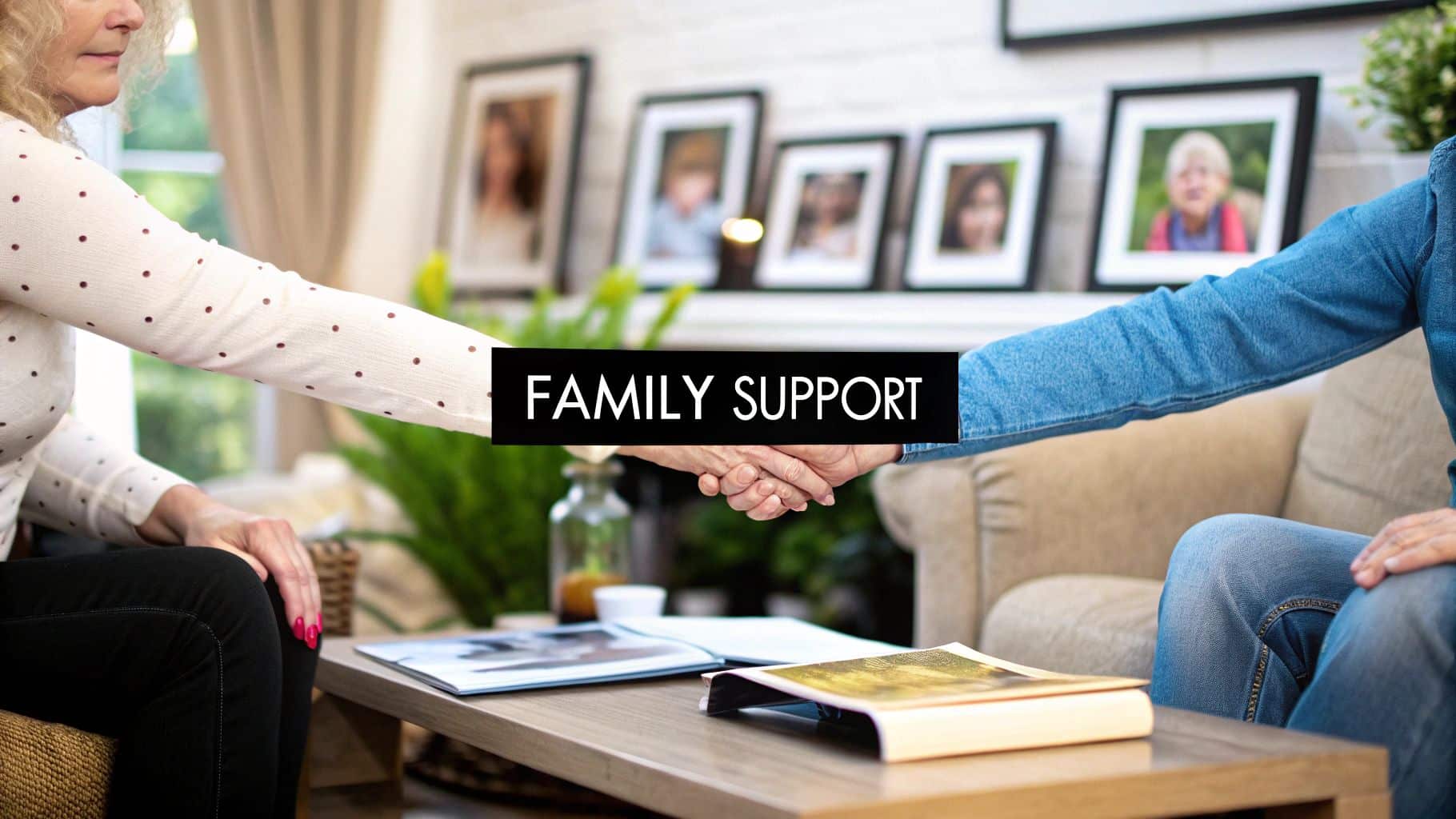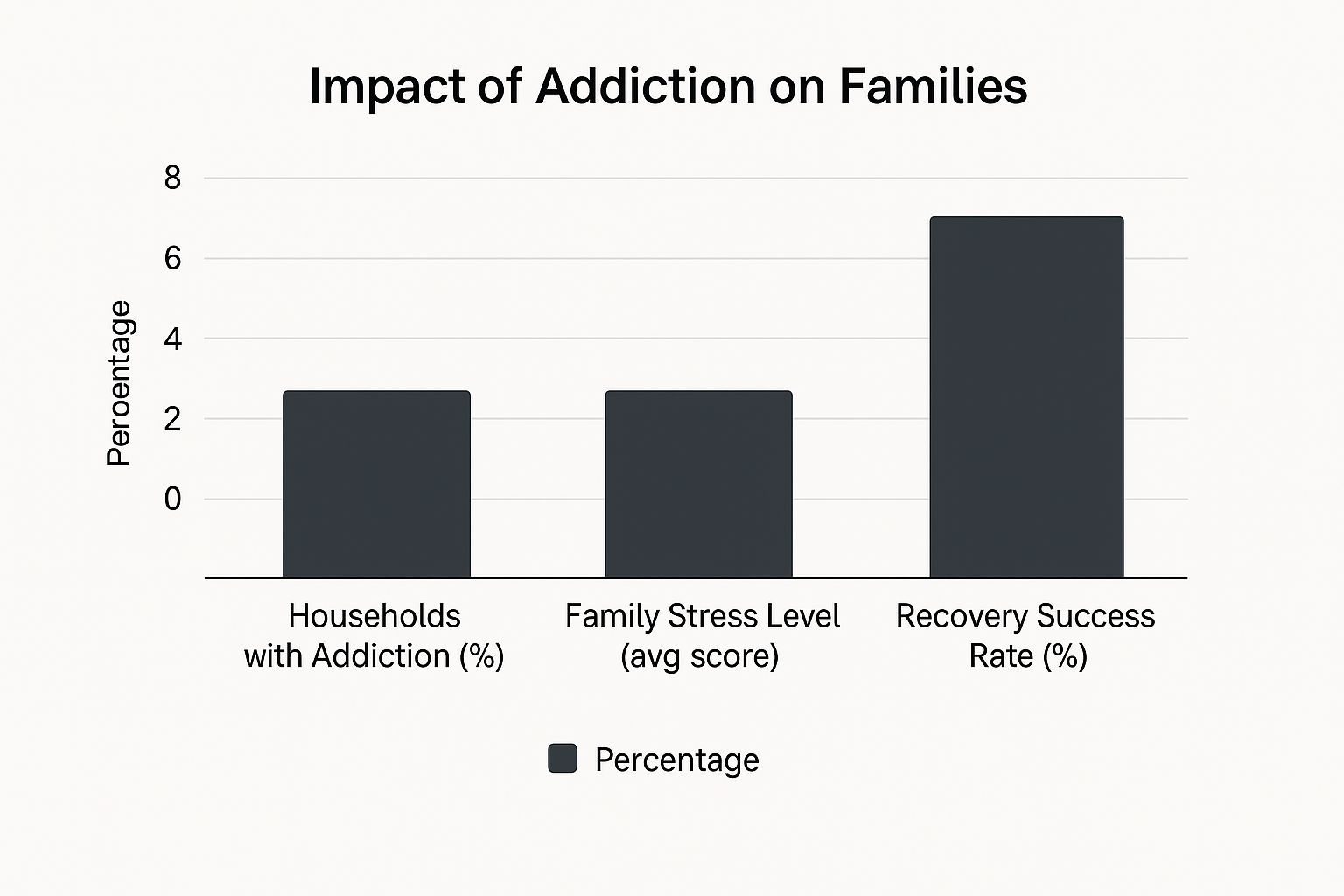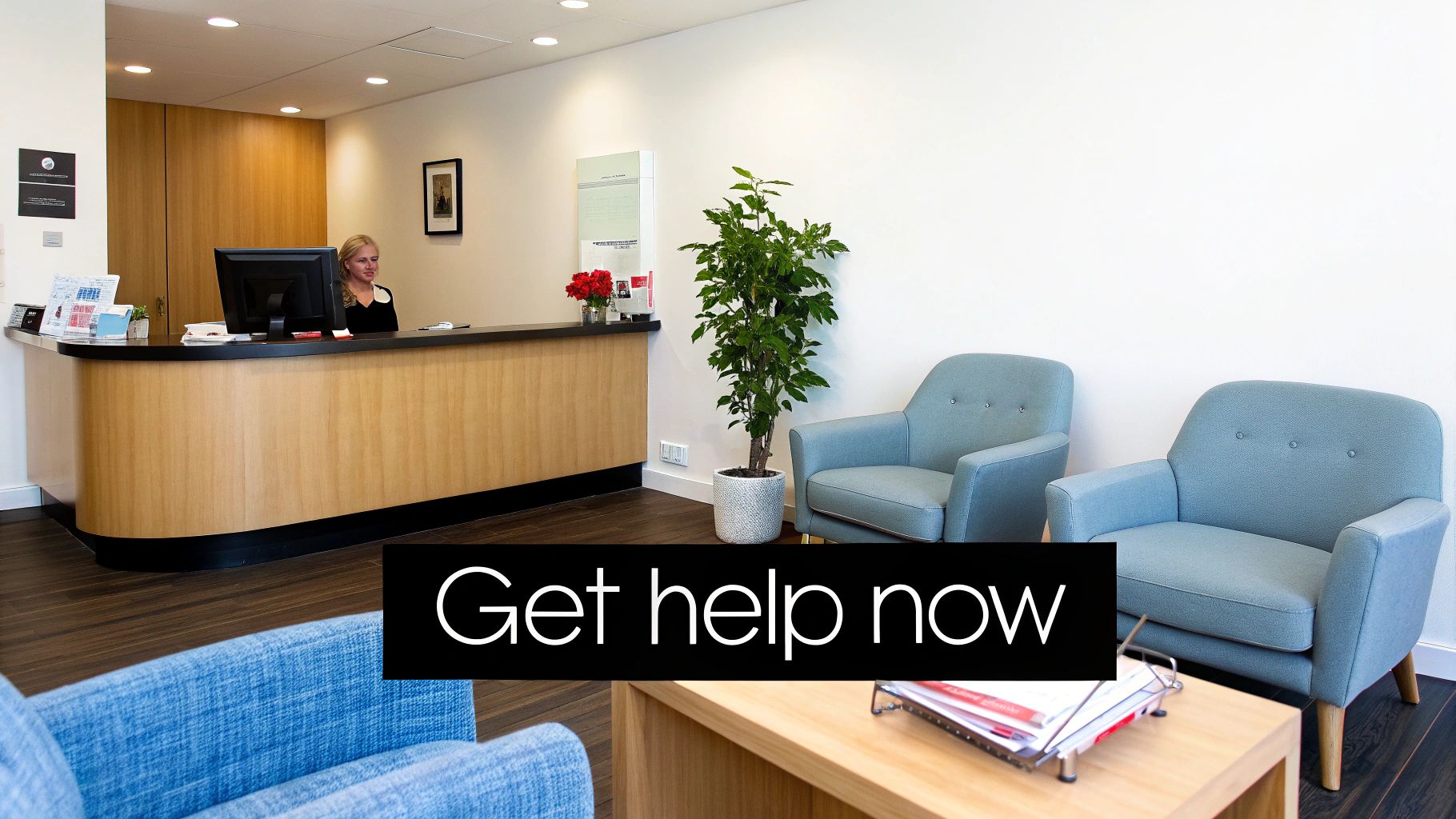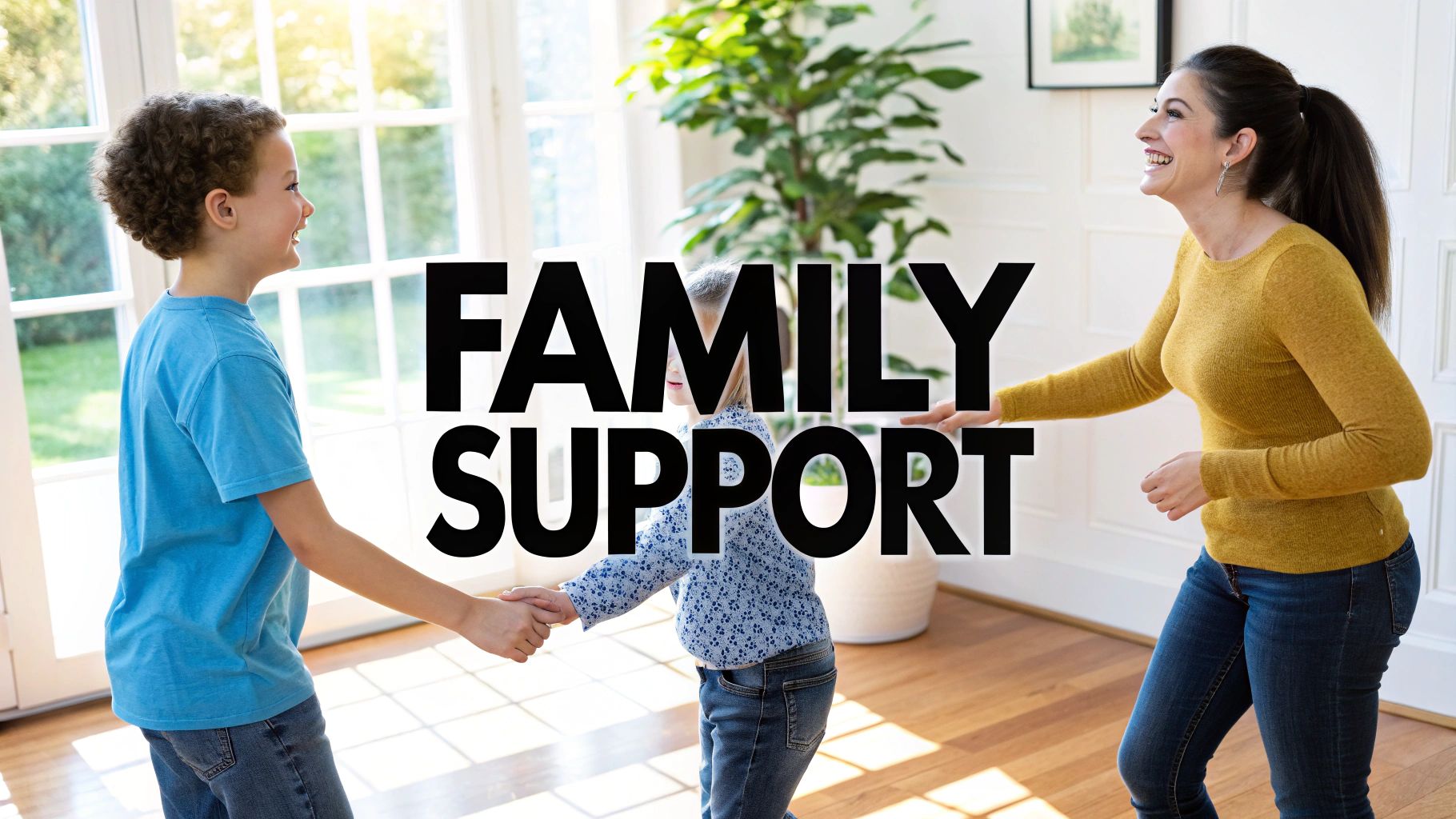
When you suspect a loved one is struggling with addiction, the first signal is often just a gut feeling. It’s not usually a big, dramatic event, but a series of small, unsettling changes. You notice shifts in their mood, their daily habits, and their personality that leave you with a nagging sense that something is deeply wrong.
Helping a family member with addiction begins right here—by learning to recognize these signs not as character flaws or choices, but as symptoms of a powerful and complex disease.
Recognizing the Signs of Addiction in a Loved One
That feeling in the pit of your stomach often shows up long before you have any concrete proof. It’s incredibly easy to second-guess yourself. Am I overreacting? Am I just being paranoid? But your intuition is one of your most valuable assets. When you feel a growing distance or sense that something is fundamentally off, it’s time to start paying closer attention.
Addiction is a master of disguise. It can look like your son suddenly abandoning a sport he’s loved his whole life or your partner becoming unusually secretive about their spending. These aren’t just random, isolated incidents; they’re often interconnected clues to a much bigger problem.
To help you connect the dots, here’s a breakdown of the common signs you might see.
Early Warning Signs of Addiction in a Family Member
The table below summarizes some of the key indicators that a substance use disorder may be developing. While one or two of these signs in isolation might not be a cause for alarm, a pattern of multiple changes across different categories is a serious red flag.
| Category of Sign | Specific Examples to Look For |
|---|---|
| Behavioral Changes | – Neglecting responsibilities at work, school, or home. – Unexplained financial problems; constantly asking for money or having valuables go missing. – A sudden change in friends and social circles; pulling away from old friends. – Secretive behavior, lying, or being evasive about their whereabouts. |
| Psychological Changes | – Extreme mood swings, from irritability and anger to euphoria or depression. – Apathy or loss of interest in hobbies and activities they once enjoyed. – Appears anxious, fearful, or paranoid for no clear reason. – Trouble concentrating or remembering things. |
| Physical Changes | – Significant changes in appearance and personal hygiene. – Unexplained weight loss or gain. – Bloodshot eyes, abnormally sized pupils, or a constant sniffle. – Disrupted sleep patterns, like insomnia or sleeping at odd hours. |
Seeing these signs laid out can be overwhelming, but remember: this is about awareness, not accusation. Recognizing the problem is the very first step toward finding a solution.
Unpacking the Red Flags
The most obvious changes often appear in a person’s everyday life. A once-dependable spouse might start missing work or forgetting important family events. A social teenager could suddenly drop their long-time friends for a new, unknown crowd.
Keep a close eye on these patterns:
- Financial Strain: Are they constantly asking for money without a good explanation? Have you noticed missing cash or valuables? Maxed-out credit cards can be another tell-tale sign that funds are being diverted to support a substance habit.
- Neglected Responsibilities: This can look like slipping grades, poor performance reviews at work, or a general failure to keep up with household chores and personal commitments.
- Social Isolation: A sudden switch to a new group of friends, especially if they are secretive about them, is a classic warning sign. This often happens alongside pulling away from family and friends who might question their new behaviors.
These are not just bad habits. They’re indicators that life is becoming unmanageable, with substance use taking priority over everything else. Helping a family member with addiction means learning to see these behaviors for what they are—cries for help, even when they’re disguised as anger or denial.
“Addiction is a family disease. One person may use, but the whole family suffers.”
This is a common saying in recovery circles for a reason. The ripple effects of substance use touch everyone, which is precisely why family involvement is so critical for healing.
The Toll on Health and Well-Being
Beyond the behaviors you can see, addiction takes a profound toll on a person’s emotional and physical health. You might notice intense mood swings—unexplained anger one moment, followed by an unusual high the next. These emotional rollercoasters are often directly tied to the cycle of using and crashing.
The physical signs can be subtle at first, but they are there if you know what to look for. Notice any deterioration in their appearance or grooming habits? What about sudden weight loss or gain, bloodshot eyes, or a perpetually runny nose? Disrupted sleep is another big one, whether it’s chronic insomnia or sleeping all day.
This image shows just how many families are navigating this exact struggle.

The challenge of helping a family member with addiction is enormous, as substance use disorders impact millions of households. In the United States, over 21 million people have needed treatment in recent years, but only a tiny fraction have actually received it.
Shockingly, in 2023, just 14.6% of individuals with a diagnosed substance use disorder got any kind of professional help. This statistic reveals a heartbreaking gap between need and care. You can discover more addiction treatment statistics and trends to better understand the true scope of this crisis.
How to Start a Conversation About Getting Help

This is often the moment families dread most. The fear of saying the wrong thing, sparking a huge fight, or even pushing your loved one further away can feel paralyzing. It’s easy to picture a dramatic, TV-style intervention, but in my experience, that’s rarely the right path.
The real goal isn’t confrontation; it’s connection. You’re aiming to open a door to help through a conversation built on love and genuine concern. This is about changing your mindset from “fixing them” to “supporting them.” It’s a subtle but powerful shift that creates a space where they might actually hear you.
Call Now – Your Journey to Recovery Begins Today!

Take the first step towards a healthier life! Call now to connect with our compassionate team and start your recovery journey today. Your path to healing awaits!
Our recovery specialists are available 24/7 to provide support, and all calls are confidential and free. Reach out anytime – we’re here to help!
Setting the Stage for a Productive Talk
Timing and setting are everything. Trying to have this conversation when you’re stressed, exhausted, or angry is a recipe for failure. The same goes for bringing it up when your loved one is under the influence. Nothing productive will come of it.
You need a calm, private, and sober moment where you won’t be disturbed. Think about a quiet evening at home after the kids are in bed, or maybe a walk in a park where you can talk without interruption. The right environment makes them feel respected, not ambushed.
Planning Your Approach
Going in without a plan can cause the conversation to go off the rails fast. This isn’t about writing a script, but about knowing your key points and your end goal before you start.
Who should be there? Sometimes, one-on-one is best. In other situations, having another trusted and calm family member present can show a united front of support. Steer clear of anyone who is highly emotional, judgmental, or prone to blaming.
What’s your goal? It’s simple: express your concern and introduce the idea of getting professional help. It helps to have a few potential resources ready, but don’t push them. You’re just planting a seed.
What are your boundaries? You need to decide your own limits beforehand. For instance, you might decide you can no longer provide financial help if they refuse to even consider treatment. This isn’t a threat; it’s a necessary boundary to protect your own well-being.
Thinking through these points helps you stay grounded, even if things get emotional.
Using the Right Words
The language you choose will either build a bridge or put up a wall. The most effective tool you have is using “I” statements. This approach focuses on your feelings and observations, which is much less likely to make someone defensive.
An accusation like, “Your drinking is tearing this family apart,” will be met with a fight.
Instead, frame it from your perspective: “I feel so scared when I see how much you’re drinking, and I’m really worried about your health.” This shifts the focus from their behavior to your concern, a point that’s much harder to argue with.
The message should always be: “I see you’re in pain, and I want to help you through this,” not, “Your behavior is a problem, and you need to stop.”
Here are a few ways to phrase it:
- “I’ve noticed you haven’t seemed like yourself lately, and it’s making me worried.”
- “I feel so helpless watching you struggle, and I miss how things used to be.”
- “I love you, and it breaks my heart to see this happening. I want to help you find a way back.”
Preparing for Their Reaction
You have no idea how they’ll respond, so be ready for anything. They might get angry, deny everything, or even try to blame you. But they might also break down, relieved that someone has finally said something.
- Denial: “I don’t have a problem. You’re being dramatic.”
- Anger: “Who are you to judge me? Just get off my back!”
- Blame: “Well, maybe I wouldn’t drink so much if you weren’t always nagging me.”
- Acceptance: “I know… I think I need help, but I don’t know what to do.”
No matter how they react, your job is to stay calm and return to your core message of love and concern. Do not get pulled into an argument. If the conversation turns hostile, it’s okay to hit pause.
You can say, “I can see you’re upset. Let’s take a break. Just know that I’m here for you when you’re ready to talk.” This is a marathon, not a sprint. This conversation is just the first step on a very long road.
Finding the Right Professional Treatment Options
When your loved one finally says “yes” to getting help, it’s a huge moment. You might feel a wave of relief wash over you, but that can quickly turn into a new kind of overwhelm. Suddenly, you’re faced with the world of addiction treatment—a confusing landscape of acronyms, program types, and different approaches.
At this stage, your role shifts from worried family member to a clear-eyed researcher. Your job is to sift through the options to find the best possible path forward for the person you care about.
Inpatient vs. Outpatient: What’s the Real Difference?
The first big decision you’ll likely face is choosing between inpatient and outpatient care. They aren’t just different settings; they offer fundamentally different levels of support. There’s no one-size-fits-all answer here. The right choice hinges on your loved one’s specific situation—what substance they use, how deep the addiction goes, and what their personal life looks like.
Inpatient or Residential Treatment: Think of this as the most intensive, immersive option. Your loved one lives at the facility 24/7, which means they have round-the-clock medical supervision and therapeutic support. This is often the best choice for people with severe, long-term addictions, those also struggling with mental health issues (like depression or anxiety), or anyone who doesn’t have a stable, trigger-free home to return to each day.
Outpatient Treatment: This model offers more flexibility. The person lives at home but attends therapy sessions and support groups at a clinic on a set schedule. It’s a solid option for individuals whose addictions are less severe, who have a strong support system at home, and who need to continue working or caring for family. Programs can range from a few hours a week to more structured partial hospitalization programs (PHP).
Making this call is critical. Inpatient care can be a life-saving safe harbor for someone in crisis. Outpatient, on the other hand, allows someone to practice their new recovery skills in the real world while still getting professional guidance. To get a better feel for the commitment, it helps to understand how long rehab might last and the factors that shape the timeline.
What to Look for Inside a Treatment Program
Beyond the setting, you need to know what makes a program effective. Getting familiar with these key components will help you cut through the marketing jargon and see what a facility truly offers.
Medically Supervised Detox
Detox is the first physical hurdle. It’s the process where the body clears itself of substances, but it comes with withdrawal symptoms. For substances like alcohol, benzodiazepines, and opioids, withdrawal isn’t just miserable—it can be life-threatening. A medically supervised detox ensures a professional team is there to manage symptoms and keep your loved one safe.
Medication-Assisted Treatment (MAT)
This isn’t about trading one drug for another. MAT is an evidence-based approach that uses specific, FDA-approved medications alongside behavioral therapy. These medications work to reduce intense cravings and stabilize body functions, giving the person a solid footing to engage in therapy and build a real recovery. It’s considered a gold standard for treating opioid and alcohol addiction.
“Addiction treatment is a massive part of the healthcare economy, not some small niche. Globally, the market was valued at over USD 10 billion in 2022. In the U.S. alone, the industry is expected to blow past $53 billion by 2025. This just goes to show the sheer scale of services available—your task is finding the quality ones.”
How to Vet a Treatment Facility Like a Pro
With so many programs out there, you have to be ready to ask tough questions. Don’t be intimidated by the admissions staff; their job is to answer you. Get a notebook and be prepared to grill them a bit.
Key Questions to Ask Admissions Counselors:
- Are you licensed and accredited? Look for state licensing plus accreditation from respected bodies like The Joint Commission or CARF. This is non-negotiable.
- What’s your treatment philosophy? Do they rely on proven, evidence-based methods like Cognitive Behavioral Therapy (CBT) or Motivational Interviewing? Or is it more of a one-size-fits-all, vague approach?
- Do you treat dual diagnosis? If your loved one also battles depression, anxiety, or another mental health condition, the facility must be equipped to treat both at the same time. This is critical.
- Can you walk me through a typical day? Ask for a schedule. You want to see a healthy mix of individual therapy, group sessions, and other structured activities—not a lot of unstructured downtime.
- How do you involve the family? Good programs know addiction affects the whole family. They should offer family therapy, educational workshops, or regular check-ins.
- What are the full costs? Get a clear, itemized breakdown of all expenses. Then, call your insurance provider yourself to verify exactly what they will and will not cover. Don’t just take the facility’s word for it.
Finding the right professional help is one of the most powerful things you can do. It’s how you turn a chaotic, desperate situation into a structured, hopeful plan for healing.
Call Now – Your Journey to Recovery Begins Today!

Take the first step towards a healthier life! Call now to connect with our compassionate team and start your recovery journey today. Your path to healing awaits!
Our recovery specialists are available 24/7 to provide support, and all calls are confidential and free. Reach out anytime – we’re here to help!
Supporting Long-Term Recovery and Navigating Relapse

When your loved one finishes a formal treatment program, it’s easy to feel like everyone has crossed the finish line. But recovery isn’t a single event—it’s a lifelong journey. Your role now shifts from crisis management to providing steady, long-term support. The period right after treatment is incredibly fragile, and a stable, encouraging home is one of the most powerful defenses against relapse.
The goal is to help create a new normal. This new life is built on healthy habits, open communication, and mutual respect. It doesn’t mean you have to walk on eggshells, but it does require a conscious effort to make your home a truly safe space for recovery.
Creating a Supportive Home Environment
The transition from a structured treatment facility back to the unpredictability of daily life can be jarring. Your loved one is returning to the same world, but they are a different person trying to live a different way. You can ease this adjustment by making some intentional changes at home.
Start with the obvious triggers. Get rid of any alcohol, old prescriptions, or paraphernalia in the house. This is a simple, tangible step that clearly signals your commitment to their sobriety.
Next, focus on building new, healthy routines together. It doesn’t have to be complicated.
- Share a healthy meal together each night.
- Go for a walk after dinner.
- Plan sober weekend activities, like hiking, seeing a movie, or visiting a museum.
These shared experiences help replace old, destructive patterns with positive connections, slowly rebuilding trust and strengthening your family bond. Remember to celebrate the small victories, too. Acknowledging a 30-day sobriety milestone or simply recognizing their hard work reinforces their progress and shows them you see their effort.
Understanding and Responding to Relapse
It’s the fear every family holds: what if they use again? The first thing to understand about relapse is that it is not a sign of failure or a lack of willpower. Addiction physically changes brain chemistry, creating powerful compulsions that can resurface even after long periods of sobriety.
“Relapse is a common part of the recovery process for many, not a moral failing. Viewing it as a setback, rather than a catastrophe, allows you to respond with compassion and refocus on the path forward without giving up hope.”
Research shows that addiction relapse rates are similar to those for other chronic illnesses like diabetes or hypertension. It simply means the treatment plan needs adjustment, not that the person has failed.
How you respond in that moment is critical. Reacting with anger or blame will only fuel shame and push your loved one further away. Instead, aim for a calm but firm approach. Reiterate your love and support while also holding fast to the boundaries you’ve established.
Reinforcing Boundaries with Compassion and Firmness
Navigating a relapse requires a delicate balance. You have to offer compassion without falling back into old, enabling behaviors. This is one of the hardest parts of supporting a family member with addiction, but it’s also one of the most important.
For example, if a boundary is that you will not provide money, you must stick to it, even if they are in distress. Instead of giving them cash, you can offer real, constructive help.
- Offer Support, Not Solutions: Say, “I’m so sorry you’re going through this. How can I help you get back to your support network? Can I drive you to a meeting or help you call your sponsor?”
- Encourage Professional Help: Gently guide them back toward their treatment resources. “It sounds like it’s time to check in with your therapist or the aftercare program. They have the tools to help you get back on track.”
Having a solid relapse prevention plan in place before a crisis happens is also essential. A clear set of steps can make all the difference when emotions are running high. For proactive ideas, you can explore our guide on effective relapse prevention strategies to be better prepared.
The data is encouraging. Between 85% and 95% of people who complete rehab report staying drug-free nine months later, and 80% notice a better quality of life. This highlights just how crucial a comprehensive plan involving family support truly is. Your ongoing support is a key ingredient in that success.
Call Now – Your Journey to Recovery Begins Today!

Take the first step towards a healthier life! Call now to connect with our compassionate team and start your recovery journey today. Your path to healing awaits!
Our recovery specialists are available 24/7 to provide support, and all calls are confidential and free. Reach out anytime – we’re here to help!
Why You Need to Take Care of Yourself Too

When you’re supporting a family member struggling with addiction, it’s easy to make their recovery your entire world. You’re constantly on high alert, managing crises, and pouring every ounce of emotional energy into them. In that exhausting process, it’s dangerously easy to neglect your own well-being.
This isn’t selfishness. It’s survival.
You simply can’t be a steady anchor for someone caught in a storm if you’re drowning yourself. Helping a loved one navigate addiction is a marathon, not a sprint, and it takes a heavy toll. If you burn out, you won’t be able to help anyone.
Are You Enabling or Helping?
You’ll often hear the terms codependency and enabling in recovery circles. It’s crucial to understand them because these patterns, though rooted in love, can accidentally get in the way of your loved one’s healing. Taking an honest look at your own behavior is one of the most powerful things you can do.
Codependency is an emotional pattern where your self-worth gets tangled up in “fixing” someone else. You might feel an overwhelming need to be needed, often pushing your own health, happiness, and stability to the back burner.
Enabling refers to the actions that stem from that mindset. It’s when you shield your loved one from the natural consequences of their choices, which ultimately removes their incentive to change.
Spotting Enabling Behaviors in Yourself
Do any of these sound familiar? So many of us fall into these traps without even realizing it.
- Making excuses for them to their boss, friends, or other relatives.
- Covering their rent, bills, or legal troubles that arise from their substance use.
- Lying to protect them or downplay the severity of the problem.
- Putting your own needs—like sleep, friendships, or hobbies—on hold to deal with their latest crisis.
Breaking these habits is incredibly difficult because it can feel cruel. But allowing your loved one to face the real-world results of their actions is often the kindest and most effective thing you can do. It can be the catalyst that finally pushes them toward genuine recovery. To learn more about fostering a healthy environment, check out our guide to help a drug addict on their recovery journey.
“You can’t control another person’s recovery, but you can control your own responses. Setting boundaries is not about punishing them; it’s about protecting yourself and modeling healthy behavior.”
Building a Foundation of Self-Care
Taking care of yourself isn’t a grand, one-time gesture. It’s a series of small, intentional actions that replenish the energy this struggle drains from you every single day. It’s about giving yourself permission to step back from the chaos.
1. Set and Hold Firm Boundaries
Boundaries are simply the rules of what you will and will not accept. They aren’t threats; they are statements of self-respect. For example: “I love you, but I will no longer give you money for any reason,” or “You are always welcome in my home, but not when you are under the influence.” State them calmly and, most importantly, enforce them every time.
2. Find Your Own Support System
You cannot do this alone. Finding others who truly get it is a game-changer. Support groups like Al-Anon and Nar-Anon are incredible resources, offering a safe space to connect with other families who understand the rollercoaster of emotions you’re on.
Individual therapy is another powerful tool. A good therapist can help you work through the complex feelings of guilt, anger, and grief while teaching you practical coping skills to manage the stress.
3. Don’t Neglect Your Physical Health
Chronic stress takes a massive toll on the body. Prioritize getting enough sleep, eating nutritious food, and moving every day. You’d be surprised what a 20-minute walk can do for your mindset and your ability to handle the day’s challenges.
Call Now – Your Journey to Recovery Begins Today!

Take the first step towards a healthier life! Call now to connect with our compassionate team and start your recovery journey today. Your path to healing awaits!
Our recovery specialists are available 24/7 to provide support, and all calls are confidential and free. Reach out anytime – we’re here to help!
Common Questions About Family and Addiction
When you’re caught in the storm of a loved one’s addiction, your mind races with urgent, high-stakes questions. The constant uncertainty can be just as exhausting as the conflict itself. Here, we’ll tackle some of the most common and gut-wrenching questions families face, offering direct answers and practical next steps for situations that feel utterly impossible.
My goal is to give you some clarity when things feel chaotic. We’ll walk through what to do when your loved one refuses help, how to handle the financial fallout, and what your options are when their safety is in immediate jeopardy.
What if They Refuse to Get Help?
This is easily the most common and heartbreaking scenario. You’ve laid your heart on the line, you’ve pleaded, you’ve researched, you’ve offered solutions—only to be met with a hard “no.” It feels like hitting a brick wall, but I promise you, this isn’t the end of the road.
The key is to shift your focus. You can’t control their decision, but you absolutely can control your own actions and the environment you create. If they won’t accept help, it’s time to get serious about your boundaries. This isn’t about punishment; it’s about survival and refusing to enable the addiction any longer.
- Cut off the financial pipeline. Stop paying their rent, covering their car payment, or handing over cash. It’s tough, but letting them experience the real-world financial consequences of their choices can be a powerful catalyst for change.
- Set clear rules for your home. It’s perfectly fair to say, “I love you, and I want you in my life, but I cannot have drugs or alcohol in my home. If you’re using, you can’t be here.” This isn’t kicking them out; it’s protecting your own peace.
- Keep the door to help open. You’re not cutting them off emotionally. You can still say, “I’ve found some programs that seem like a great fit. Whenever you’re ready, I’ll be right here to make the calls with you.”
Remember, you can’t force an adult into treatment unless they are an immediate danger to themselves or others. Your real power lies in changing your own behavior, not theirs.
How Do We Manage the Financial Impact?
Addiction carries a staggering price tag, and it’s not just the person using who pays it. It can decimate savings, create crushing debt, and threaten the entire family’s stability. Protecting your family’s financial health isn’t selfish—it’s essential.
The first, non-negotiable step is to financially untangle yourself. This might feel drastic, but it’s crucial. This means separating bank accounts, removing their name from your credit cards, and securing your assets. You have to prevent the addiction from sinking the whole family ship.
“You are not a human ATM. Your financial support may be prolonging the addiction by cushioning them from the reality of its cost. By setting financial boundaries, you are not abandoning them; you are helping them feel the full weight of their choices, which is often a prerequisite for seeking help.”
When it comes to paying for treatment, become an informed consumer. Get on the phone with your insurance provider and get a clear, written confirmation of exactly what your policy covers. Don’t be afraid to ask treatment centers directly about scholarships, grants, or flexible payment plans—many have them available.
When Is It Time for Emergency Action?
Sometimes, the situation spirals into a full-blown crisis where your loved one becomes a clear danger to themselves or others. This is the moment to stop talking and start acting to ensure everyone’s safety.
These are critical warning signs that demand an immediate response:
- Any threats of suicide or talk of self-harm.
- Severe paranoia, hallucinations, or psychotic episodes.
- An overdose or other serious medical complications from substance use.
- Any violent or physically threatening behavior toward you or anyone else.
If you see any of these signs, don’t hesitate. Your priority is immediate safety. Call 911 or get them to the nearest emergency room.
Depending on your state, you may also be able to pursue legal options like involuntary commitment or use civil commitment laws (such as Casey’s Law or the Marchman Act) to mandate an assessment and treatment. These are complex legal tools designed for dire situations where a person is no longer capable of making rational decisions about their own well-being.
Navigating the immense challenges of addiction can feel isolating. You don’t have to walk this path alone. The team at Addiction helpline America is available 24/7 to offer confidential, compassionate support and guide you to the resources you need. For help with treatment options, finding support groups, or just to have someone listen, please visit the Addiction helpline America website.
Our helpline is 100%
free & confidential
If you or someone you care about is struggling with drug or alcohol addiction, we can help you explore your recovery options. Don’t face this challenge alone—seek support from us.
Programs
Resources
Will my insurance
cover addiction
treatment?
We're ready to help
Find the best
drug or alcohol treatment
center
Are you or a loved one struggling with addiction? Call today to speak to a treatment expert.















